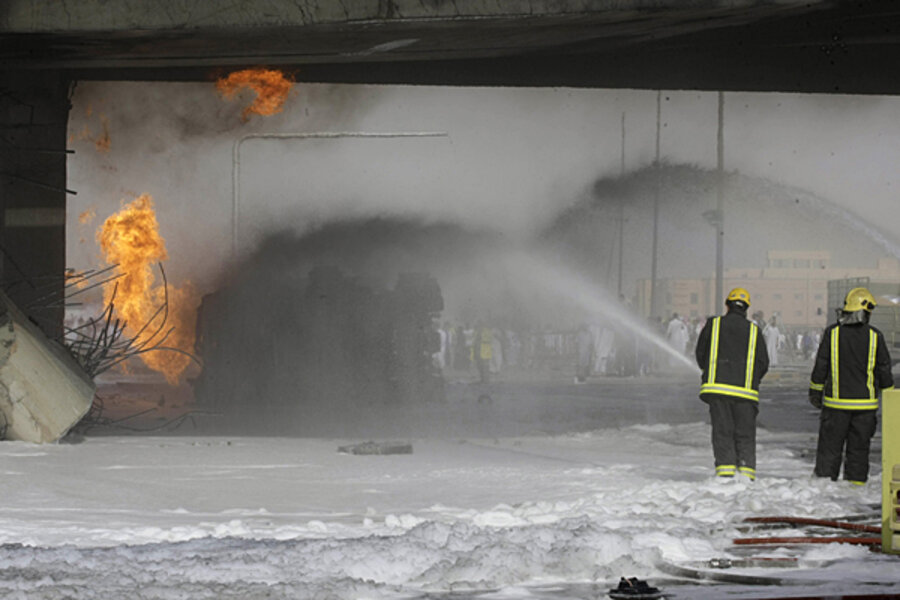Fuel truck explosion kills 23 in Saudi Arabia; Are US trucks safe?
Loading...
A fuel truck explosion in Riyadh, Saudi Arabia, which killed at least 23 people and injured more than 110, grabbed wide attention Thursday when leaking gas caused an explosion in a nearby warehouse.
While preliminary reports suggest the accident was an unusual, isolated incident, it begs the question: How safe are fuel tankers? They deliver fuel to gasoline stations in the United States and around the world. So how common are large explosive accidents?
“Occurrences do happen, but they’re very rare considering the number of miles traveled with these trucks every day and every year,” said Matthew Manoli, safety director at Dennis K. Burke Inc., a family-owned, Massachusetts-based fuel-delivery company.
Of the 3,484 large trucks involved in fatal crashes in 2010 in the US, 51 contained flammable liquids such as gasoline and fuel oil, according to an August 2012 report by the Federal Motor Carrier Safety Administration.
The total number of large trucks involved in fatal accidents declined 30 percent between 2000 and 2010. Some attribute the drop to more stringent hours of service rules, which determine driver shift lengths.
That's a miraculous safety record, considering the “heck of a lot of loads that go to gas stations each day,” says Dan Furth, president of National Tank Truck Carriers, a Washington-based association.
Still, accidents happen.
In 2009, an older fuel-tanker truck that did not have the most recent stability controls, rolled over in Indianapolis, spilling 9,001 gallons of liquefied petroleum gas. The trucker and another driver sustained serious injuries, and the incident prompted an investigation by the National Transportation Safety Board into retrofitting tankers with anti-rollover technology.
The explosion Thursday near the Saudi Arabian National Guard and the Prince Nayef Arab College for Security Sciences in the Saudi capital was triggered after the truck crashed into a bridge, according to officials on state television, who called it an accident.
“The truck driver was surprised by a road accident on its route, causing it to crash into one of the pillars of the bridge,” Captain Mohamed Hubail Hammadi, a spokesman said.
The accident was compounded when leaking gas caused an explosion in a nearby heavy machinery and vehicles warehouse, according to SPA, the state news agency.
In the US, those in the industry emphasize a few factors that make transporting fuel a relatively safe operation here:
Tank design
Many of the long fuel-carrying tubes you see flying down the highway are actually broken up into smaller containers inside, to account for different kinds of fuel. This minimizes the content’s movement, experts say, thereby keeping the liquids stable. It also ensures that if one section is damaged, the leak is likely to be contained. Because gasoline has a low center of gravity, the flat, oblong shape of the tank helps prevent trucks from rolling over, Mr. Furth says.
Electronic sensors
Most new fuel tank trucks include a variety of electronic sensors that help prevent accidents. One kind of stability system automatically applies the brakes when excessive weight is measured on one side of the vehicle. This helps prevent trucks from rolling over on sharp turns.
Driver quality
“The core of our whole safety program is our drivers and our hiring practice,” Mr. Manoli says. “We don’t just turn the keys over to anyone who walks in the door.”
Background checks, road tests, and routine training should all be a part of a trucking company’s safety program, he adds. At a base level, drivers of cargo tank motor vehicles transporting hazardous materials are generally required to obtain a commercial driver’s license with special certification for hazardous materials and fuel tanks, according to the Pipeline and Hazardous Materials Safety Administration, which writes hazardous materials regulations for the Department of Transportation.
As for other vehicles on the road, industry experts said drivers should exercise the same caution around fuel tankers that they would for any kind of large truck. Avoid the truck’s blind spot, they say, and don’t brake abruptly in front of a truck as they take longer to stop.
– Material from the Associated Press and Reuters was used in this report.






